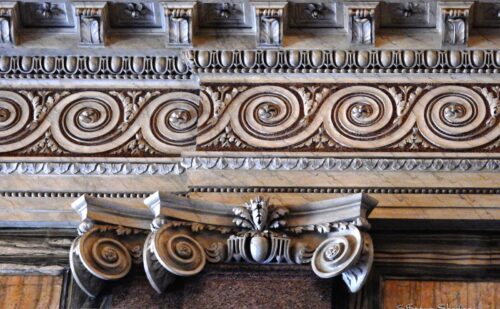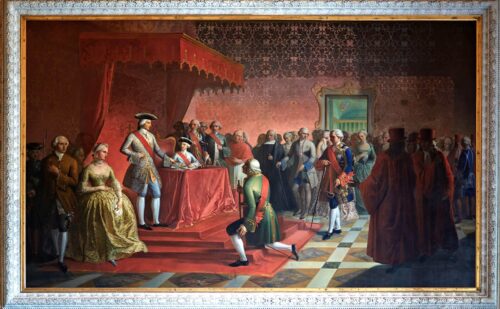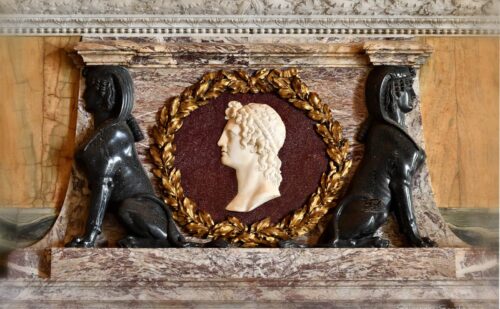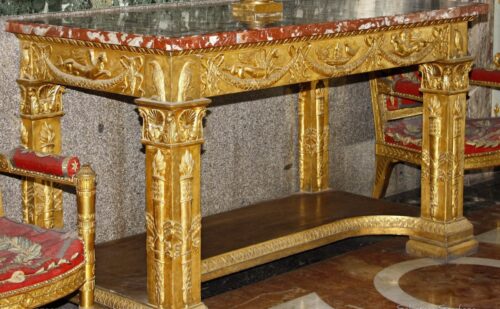The Hall of Alexander, the Antechamber for the Untitled
The Hall of Alexander was initially used as the Throne Room
Description
The Antechamber for the Untitled” i.e. for ordinary people, known today as the Hall of Alexander, was used as the throne room until the new one was built, which only took place in 1845. This hall was the most modified over time, both while it was under construction that by the various kings.
Decorations and furnishings
The fresco
The Antechamber for the non-titled" is today known as Hall of Alexander due to the fresco with "The wedding of Alexander the Great and Rossane" painted by Mariano Rossi in 1786, a very renowned painter within the Accademia di San Luca , in the circle of Bottani and Albani and acquiring considerable fame among the enlightened clients of the end of the eighteenth century. The purpose of the fresco was, obviously, to celebrate the glories of the Bourbon Dynasty.
The fresco of the Hall of Alexander, paid for 5,000 ducats, depicts a procession of men and women, richly dressed, to celebrate the glories of the Bourbon monarchy and the marriage alliances that guarantee the survival of the dynasty and peace in the kingdom. The flourishing of peace is symbolized by the divinities Bacchus, Mars and Hercules at rest among the meek beasts.
Problems arose between the architect Carlo Vanvitelli and the painter Mariano Rossi. In fact, once the fresco was finished, the slender Corinthian order of the walls seemed too slender to be proportionate to the gigantism of the figures represented. The architect did not want to destroy the beautiful cornice already completed and preferred to modify the flat column making it more massive, abandoning the Corinthian order.
In 1805, Mariano Rossi himself was also commissioned to paint the two large paintings within the stucco frames, carved by Carlo Beccalli and Giuseppe Zappi, not created due to the painter's supervening death.
The decoration of the Hall
When Ferdinando fled to Sicily the Hall of Alexander was not completed, but it was under the reign of Gioacchino Murat (1805-1815), who had six overdoors executed in high relief with episodes from his life while, on the main walls where paintings by the Mariano Rossi himself (who died in the meantime), wanted them to be painted:
- Heinrich Schmidt (1757-1821) - "The Capitulation of Capri"
- Rudolph Suhrlandt (1781-1862) - "The Battle of Eylan"
With the return of the Bourbons, Murat's overdoors and celebratory frescoes were obviously destroyed and replaced by plaster. Eleven years passed and in 1826 the two large replacement canvases were ready:
- Vincenzo Camuccini (1771-1844) - "The killing of Caesar";
- Vincenzo Camuccini (1771-1844) - "The death of Virginia".
Regarding the overdoors, the architect Niccolini stated that they had to be canvases with a Roman subject so as not to clash with Camuccini's paintings, but the latter wanted episodes from the life of Alexander, obtaining the King's approval. When the panels were ready, the King considered it inappropriate for fake high reliefs to be inserted in a marble room, so the architect Niccolini had them made in scagliola by the sculptors Tito Angelini and Gennaro Cali, highly recommended by the famous sculptor Bertel Thorvaldsen. On the other hand, the initial project by Carlo Vanvitelli included six high-relief overdoors dedicated to Alexander the Great.
Camuccini's paintings, on the other hand, were initially taken to the Royal Palace of Naples, then to the Capodimonte palace and two canvases were replaced in homage to King Charles of Bourbon, founder of the Dynasty:
- Gennaro Maldarelli (1795-1858) - "The abdication of the throne of Charles of Bourbon in favor of his son Ferdinand"
- Camillo Guerra (1797-1874) - "The Victory of Charles of Bourbon at the Battle of Velletri"
Only in 1850, with the arrangement of the current canvases, was completed the decoration of the Antechamber for the Untitled.
Furnishings of the Hall of Alexander
Upon his return, King Ferdinand eliminated all that celebrated Murat and Napoleon, but remained hesitant in the face of the beautiful furniture that Joseph Bonaparte had brought from Paris, as they had the upholstery embroidered with the letter G of Joseph Bonaparte. Therefore this letter was covered with Ferdinando’s monogram in order to save these furnishings. Ironically, if Napoleon was extremely hated by all European sovereigns whose kingdoms were conquered, the Empire style was extremely loved by all European sovereigns, who kept it for another 30 years.
The fireplace is decorated with a laurel-crowned Portrait of Alexander the Great.
External link












